HCI – the Possibilities Are Endless

The following is a guest post by Carlos Lazo and originally appeared on his blog. Carlos is currently a student at The Flatiron School. You can follow him on Twitter here. One of the things that has most fascinated me about the world of technology is our ability (and even sometimes, inability) to interact with computers. You hear […]
The following is a guest post by Carlos Lazo and originally appeared on his blog. Carlos is currently a student at The Flatiron School. You can follow him on Twitter here.
One of the things that has most fascinated me about the world of technology is our ability (and even sometimes, inability) to interact with computers. You hear about things like(https://en.wikipedia.org/wiki/Artificial_intelligence “Definition of Artificial Intelligence”), self-realizations regarding the possibilities seen in the movie The Matrix, and prophecies of when SkyNet will take over the world.
Interestingly enough, this is where HCI comes into play.
What is HCI?
As defined by Wikipedia:

HCI extends in to a variety of different realms, encompassing things we take for granted like website interaction all the way to virtual reality. Our day to day communication with our computers, whether physical or emotional, defines our overall user experience (UX). The user interaction (UI) is a large part of what we as web developers can control.
Coming from a computer engineering / hardware background, I’ve always had a great interest exploring the combined space of gaming, hardware, and HCI. So that got me thinking… does an API exist that allows me to interface with the Microsoft Kinect?
Hacking the Microsoft Kinect
I’ve owned a Microsoft Kinect since the day it was publicly released, and to this day, am continually impressed by its raw power and how its changed the space of gaming. In doing some research, it appears like there are a few Ruby wrappers in existence that allow for direct interface with the hardware. Luckily, the only requirements for the software were a computer with USB ports and lots of time.
At the high level, here are some quick data points I discovered while analyzing two ruby gems:Kinect-Ruby Processing and Ruby-Freenect.

Now to see the contenders in a little more detail!
Kinect-Ruby Processing
The (https://github.com/mudphone/Kinect-Ruby-Processing “Github of Kinect-Ruby Processing gem”) gem interfaces directly with the Ruby Processing (rp5) library. Using this raw power that many don’t realize Ruby can handle, it interfaces directly with the hardware and can provide functionality as described in the previous section.
Here are images taken directly from the Kinect:
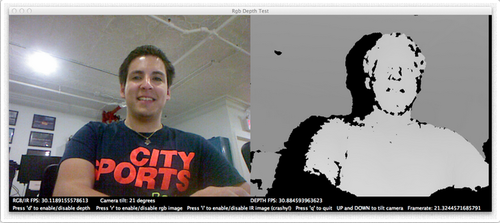
Kinect-Ruby Processing: RGB with Depth Map

Kinect-Ruby Processing: Infrared with Depth Map
So… you’re probably asking yourself, what does some of this code look like? Let’s see:
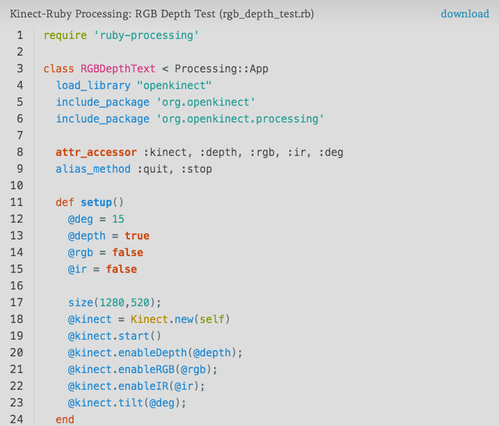
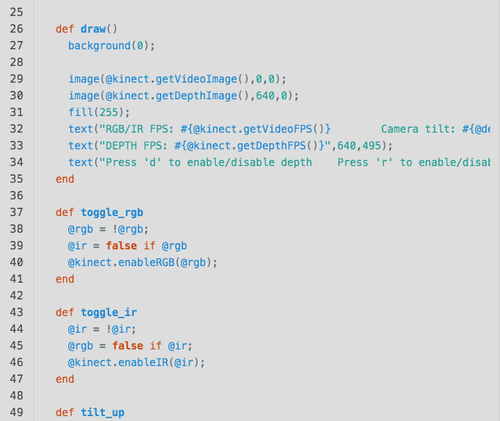
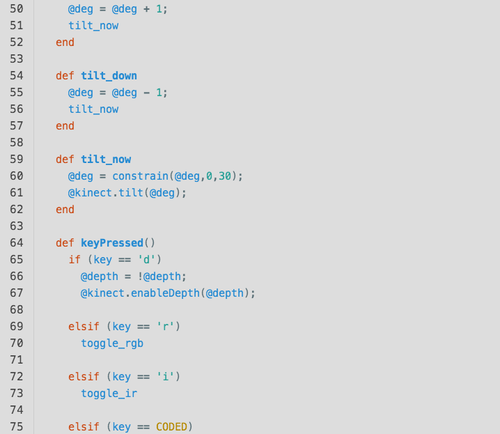

And this is the beauty of the Ruby programming language! Even if you didn’t know a thing about Ruby and the way it is structured, the code above is readable and easy to understand.
One thing to definitely note about this gem is its gracefully ungraceful way of crashing around 50% of the time when attempting to enable the IR mode:
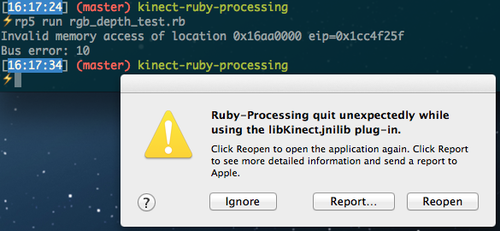
Understandably, I guess some bugs still need to be worked out.
Ruby-Freenect
As is customary in the world today, there tend to be more than one way of doing things. Let’s take a quick peek at some output from the Kinect via the (https://github.com/troystribling/ruby-freenect “Github of Ruby-Freenect gem”) gem:
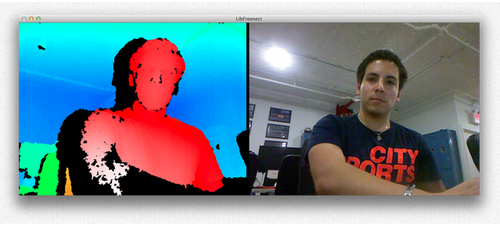
Ruby-Freenect: Depth Map with RGB

Ruby-Freenect: Depth Map with InfraRed (IR)
As you may have noticed, this Ruby gem outputs the depth map in a colored format based on distance. As you can see in the next picture, objects that are closer to the camera appear in a ‘hotter’ color (black/red), while objects further away are a ‘colder’ color (green/blue):

Engaging this library package is done via the ‘opengl’ command. I still have to do some exploration in order to find the code base. This gem also seems to lose packets, and does so in a more graceful “I don’t crash the entire program way.”
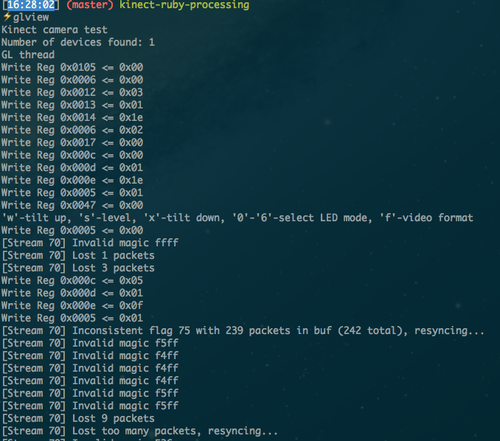

It is a bit interesting though – sometimes, the video feed gets stuck, and you see a combination of the three video feeds. Constantly hitting the video button will eventually restore the connection, which is nice. Failure output, while never good to see, also tells me that an issue occurred, which is better than nothing.
The Future is Now
My current plan is to explore the world of HCI via the Microsoft Kinect during my semester here at the Flatiron School. The exploration of this hardware interface, perhaps through gamification, will allow me to hopefully (1) contribute to open source and (2) understand the what is possible and what isn’t.
Simply stated:

Stay tuned for more information on the Kinect.
Disclaimer: The information in this blog is current as of July 1, 2013. Current policies, offerings, procedures, and programs may differ.



